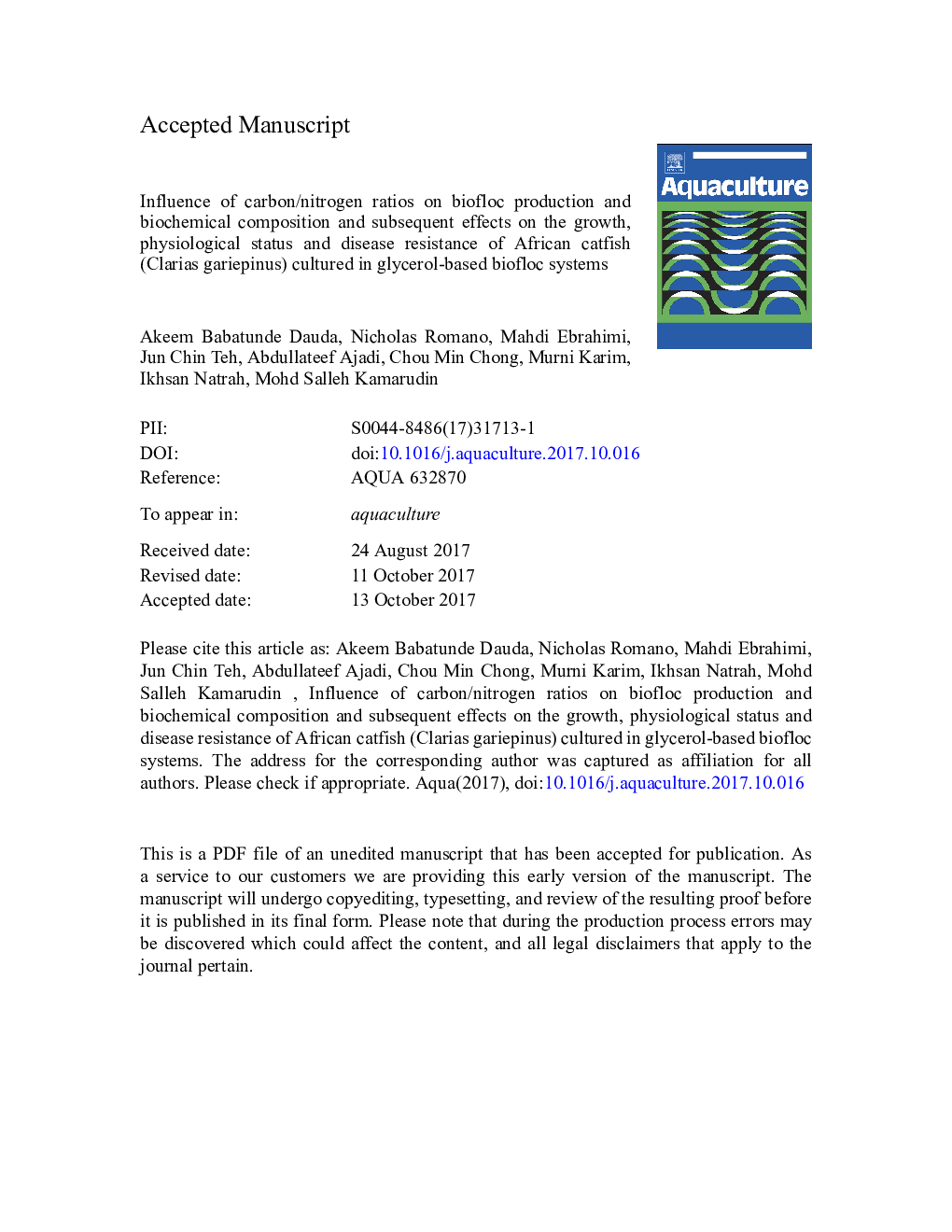| کد مقاله | کد نشریه | سال انتشار | مقاله انگلیسی | نسخه تمام متن |
|---|---|---|---|---|
| 5538995 | 1552805 | 2018 | 50 صفحه PDF | دانلود رایگان |
عنوان انگلیسی مقاله ISI
Influence of carbon/nitrogen ratios on biofloc production and biochemical composition and subsequent effects on the growth, physiological status and disease resistance of African catfish (Clarias gariepinus) cultured in glycerol-based biofloc systems
دانلود مقاله + سفارش ترجمه
دانلود مقاله ISI انگلیسی
رایگان برای ایرانیان
کلمات کلیدی
موضوعات مرتبط
علوم زیستی و بیوفناوری
علوم کشاورزی و بیولوژیک
علوم آبزیان
پیش نمایش صفحه اول مقاله

چکیده انگلیسی
The effects of increasing glycerol loading rates to create carbon to nitrogen (C/N) ratios of 0 (control), 10, 15 or 20 were investigated on the biofloc formation, biochemical composition and water quality, as well as the growth performance, feeding efficiencies, biochemical composition, trypsin/chymotrypsin enzyme activities, and liver glycogen of African catfish Clarias gariepinus after 6 weeks. Each treatment was triplicated and each replicate consisted of 25 juveniles (11.77 ± 0.01 g; mean ± SE). After six weeks, all fish were measured for growth, ten fish/replicate were used for additional analysis while ten fish/replicate were later challenged with the bacterial pathogen, Aeromonas hydrophila. Biofloc volume was significantly higher (P < 0.05) at C/N 20, but biofloc biomass was significantly higher (P < 0.05) at C/N 15. Dissolved oxygen was significantly lower (P < 0.05) at C/N 20 while total ammoniaânitrogen was significantly higher (P < 0.05) in the control than the biofloc groups. Survival, growth, and feed utilization were similar among treatments (P > 0.05), but the input-output ratio significantly increased (P < 0.05) in the bioflocs groups. Fish muscle cholesterol, lipid peroxidation, serum triglyceride and serum cholesterol were all significantly lower (P < 0.05) in the biofloc groups, but liver glycogen was significantly higher (P < 0.05) in the C/N 15 treatment. Chymotrypsin activities were significantly higher (P < 0.05) in the biofloc groups, but trypsin was not different among the treatments. After challenging the catfish to A. hydrophila, survival was significantly higher (P < 0.05) in the C/N 15 and 20 groups, which was accompanied with less histopathological liver damage compared to those in the control or C/N 10 treatment. Overall, the results indicate that in a glycerol-based biofloc system, a C/N ratio of 15 led to the best balance of better water quality, nutritive value of C. gariepinus as well as their resistance to A. hydrophila.
ناشر
Database: Elsevier - ScienceDirect (ساینس دایرکت)
Journal: Aquaculture - Volume 483, 20 January 2018, Pages 120-130
Journal: Aquaculture - Volume 483, 20 January 2018, Pages 120-130
نویسندگان
Akeem Babatunde Dauda, Nicholas Romano, Mahdi Ebrahimi, Jun Chin Teh, Abdullateef Ajadi, Chou Min Chong, Murni Karim, Ikhsan Natrah, Mohd Salleh Kamarudin,